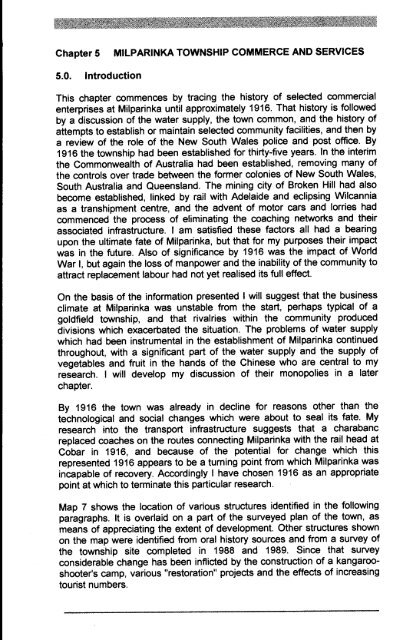Adec Preview Generated PDF File - The Sydney eScholarship ...
Adec Preview Generated PDF File - The Sydney eScholarship ...
Adec Preview Generated PDF File - The Sydney eScholarship ...
You also want an ePaper? Increase the reach of your titles
YUMPU automatically turns print PDFs into web optimized ePapers that Google loves.
Chapter 5 M1LPARINKA TOWNSHIP COMMERCE AND SERVICES<br />
5.0. Introduction<br />
This chapter commences by tracing the history of selected commercial<br />
enterprises at Milparinka until approximately 1916. That history is followed<br />
by a discussion of the water supply, the town common, and the history of<br />
attempts to establish or maintain selected community facilities, and then by<br />
a review of the role of the New South Wales police and post office. By<br />
1916 the township had been established for thirty-five years. In the interim<br />
the Commonwealth of Australia had been established, removing many of<br />
the controls over trade between the former colonies of New South Wales,<br />
South Australia and Queensland. <strong>The</strong> mining city of Broken Hill had also<br />
become established, linked by rail with Adelaide and eclipsing Wilcannia<br />
as a transhipment centre, and the advent of motor cars and lorries had<br />
commenced the process of eliminating the coaching networks and their<br />
associated infrastructure. I am satisfied these factors all had a bearing<br />
upon the ultimate fate of Milparinka, but that for my purposes their impact<br />
was in the future. Also of significance by 1916 was the impact of World<br />
War I, but again the loss of manpower and the inability of the community to<br />
attract replacement labour had not yet realised its full effect.<br />
On the basis of the information presented I will suggest that the business<br />
climate at Milparinka was unstable from the start, perhaps typical of a<br />
goldfield township, and that rivalries within the community produced<br />
divisions which exacerbated the situation. <strong>The</strong> problems of water supply<br />
which had been instrumental in the establishment of Milparinka continued<br />
throughout, with a significant part of the water supply and the supply of<br />
vegetables and fruit in the hands of the Chinese who are central to my<br />
research. I will develop my discussion of their monopolies in a later<br />
chapter.<br />
By 1916 the town was already in decline for reasons other than the<br />
technological and social changes which were about to seal its fate. My<br />
research into the transport infrastructure suggests that a charabanc<br />
replaced coaches on the routes connecting Milparinka with the rail head at<br />
Cobar in 1916, and because of the potential for change which this<br />
represented 1916 appears to be a turning point from which Milparinka was<br />
incapable of recovery. Accordingly I have chosen 1916 as an appropriate<br />
point at which to terminate this particular research.<br />
Map 7 shows the location of various structures identified in the following<br />
paragraphs. It is overlaid on a part of the surveyed plan of the town, as<br />
means of appreciating the extent of development. Other structures shown<br />
on the map were identified from oral history sources and from a survey of<br />
the township site completed in 1988 and 1989. Since that survey<br />
considerable change has been inflicted by the construction of a kangarooshooter's<br />
camp, various "restoration" projects and the effects of increasing<br />
tourist numbers.




